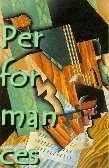|
KOSTAS KATSIYIANNIS
Casals, Fournier, Navarra & Rostropovich on Bach's
Suites for solo cello
References:
Casals, EMI Classics 077776102726 (Recording 1936-39), 2 CD
|||
Navarra, Calliope Cal 9641/2 (1977), 2 CD |||
Fournier, Deutsche Grammophon (1961) 419359-2, 2 CD |||
Rostropovich, EMI Classics (1995) 7243 5 55363 2 7, 2 CD
|
|
The Suites on the Web:
 A
Survey of Bach Suite Editions A
Survey of Bach Suite Editions
 An extraordinary performance in Australia An extraordinary performance in Australia
 Interpretational
Angst And The Bach Cello Suites Interpretational
Angst And The Bach Cello Suites
|
 HE CELLO SUITES by J.S. Bach, as
with some of his other works,still
leave questions unanswered: for a start, the precise date of their
composition remains uncertain (circa 1720), and the cello as we know it
played little part in the solo repertoire of Bach's day, so that questions
concerning the instrument (was it for the Viola da Gamba?) and the
composer's inspiration for the piece remain conjectural. Connoisseurs have
to date put forward several theories, but there is only one point they all
agree on: that the manuscript copy everyone uses as the most reliable
source -since the original has not yet been found- was handwritten by the
composer's second wife, Anna Magdalena; nevertheless the work is
considered to have been composed long before Bach had even met her. From
there on, several conjenctures have been made, which probably have no
particular importance. Another debatable point in the history of this
masterpiece is the fact that these 6 Suites -for those unacquainted with
them- are according to their title a collection of dances following one
another in strict succession. Until now, the most widespread
interpretative view has placed this feature of the work on a less
important footing, and, I dare say, it is the composer himself who is
responsible for that. Indeed, the Great Cantor, like all top composers,
was intensely improvisatory by nature; and this can be seen not only in
documents of the period, but also in manv other works by Bach - mainly the
ones he wrote for the organ. HE CELLO SUITES by J.S. Bach, as
with some of his other works,still
leave questions unanswered: for a start, the precise date of their
composition remains uncertain (circa 1720), and the cello as we know it
played little part in the solo repertoire of Bach's day, so that questions
concerning the instrument (was it for the Viola da Gamba?) and the
composer's inspiration for the piece remain conjectural. Connoisseurs have
to date put forward several theories, but there is only one point they all
agree on: that the manuscript copy everyone uses as the most reliable
source -since the original has not yet been found- was handwritten by the
composer's second wife, Anna Magdalena; nevertheless the work is
considered to have been composed long before Bach had even met her. From
there on, several conjenctures have been made, which probably have no
particular importance. Another debatable point in the history of this
masterpiece is the fact that these 6 Suites -for those unacquainted with
them- are according to their title a collection of dances following one
another in strict succession. Until now, the most widespread
interpretative view has placed this feature of the work on a less
important footing, and, I dare say, it is the composer himself who is
responsible for that. Indeed, the Great Cantor, like all top composers,
was intensely improvisatory by nature; and this can be seen not only in
documents of the period, but also in manv other works by Bach - mainly the
ones he wrote for the organ.
|
The Suites on the Web:
 The
Six Bach Suites in the "Anna Magdalena" manuscript The
Six Bach Suites in the "Anna Magdalena" manuscript
 Suites
faq Suites
faq
 PDF
files of a trombone (!) edition by Douglas Yeo
PDF
files of a trombone (!) edition by Douglas Yeo
|


 HE CELLO SUITES by J.S. Bach, as
with some of his other works,still
leave questions unanswered: for a start, the precise date of their
composition remains uncertain (circa 1720), and the cello as we know it
played little part in the solo repertoire of Bach's day, so that questions
concerning the instrument (was it for the Viola da Gamba?) and the
composer's inspiration for the piece remain conjectural. Connoisseurs have
to date put forward several theories, but there is only one point they all
agree on: that the manuscript copy everyone uses as the most reliable
source -since the original has not yet been found- was handwritten by the
composer's second wife, Anna Magdalena; nevertheless the work is
considered to have been composed long before Bach had even met her. From
there on, several conjenctures have been made, which probably have no
particular importance. Another debatable point in the history of this
masterpiece is the fact that these 6 Suites -for those unacquainted with
them- are according to their title a collection of dances following one
another in strict succession. Until now, the most widespread
interpretative view has placed this feature of the work on a less
important footing, and, I dare say, it is the composer himself who is
responsible for that. Indeed, the Great Cantor, like all top composers,
was intensely improvisatory by nature; and this can be seen not only in
documents of the period, but also in manv other works by Bach - mainly the
ones he wrote for the organ.
HE CELLO SUITES by J.S. Bach, as
with some of his other works,still
leave questions unanswered: for a start, the precise date of their
composition remains uncertain (circa 1720), and the cello as we know it
played little part in the solo repertoire of Bach's day, so that questions
concerning the instrument (was it for the Viola da Gamba?) and the
composer's inspiration for the piece remain conjectural. Connoisseurs have
to date put forward several theories, but there is only one point they all
agree on: that the manuscript copy everyone uses as the most reliable
source -since the original has not yet been found- was handwritten by the
composer's second wife, Anna Magdalena; nevertheless the work is
considered to have been composed long before Bach had even met her. From
there on, several conjenctures have been made, which probably have no
particular importance. Another debatable point in the history of this
masterpiece is the fact that these 6 Suites -for those unacquainted with
them- are according to their title a collection of dances following one
another in strict succession. Until now, the most widespread
interpretative view has placed this feature of the work on a less
important footing, and, I dare say, it is the composer himself who is
responsible for that. Indeed, the Great Cantor, like all top composers,
was intensely improvisatory by nature; and this can be seen not only in
documents of the period, but also in manv other works by Bach - mainly the
ones he wrote for the organ.